March 17th, 2014
| 2 Comments »
Just 10 days ago, I underwent LASIK eye surgery and my life shifted in ways that I’m still learning to understand. I’m trying to make sense of it all, but only those who’ve been under the burden of eyeglasses for their entire life, then freed from the need in a quick, 7 minute procedure would be able to know why this is such a huge, life-changing shift.
So for the rest of you, I’ll just talk about pasta. Because that’s just not that big of a deal, right? But this dish I created recently, well, this IS a big deal.
I’ve been pasta-less most of the past year, and not for the standard ‘I’m carb-free’ or ‘I don’t DO pasta’ whine whine that this basic staple is devil spawn. We went through a long period where pasta was standard in our dinner repertoire, and I just became tired of it. Then, lately, there’s been that nagging sense that something was causing pure belly sadness and pasta, being cloaked in wheat, was ignored. Finally, I realized that I missed a steaming bowl of carb goodness. It was March in Minnesota, after all. Enough said.
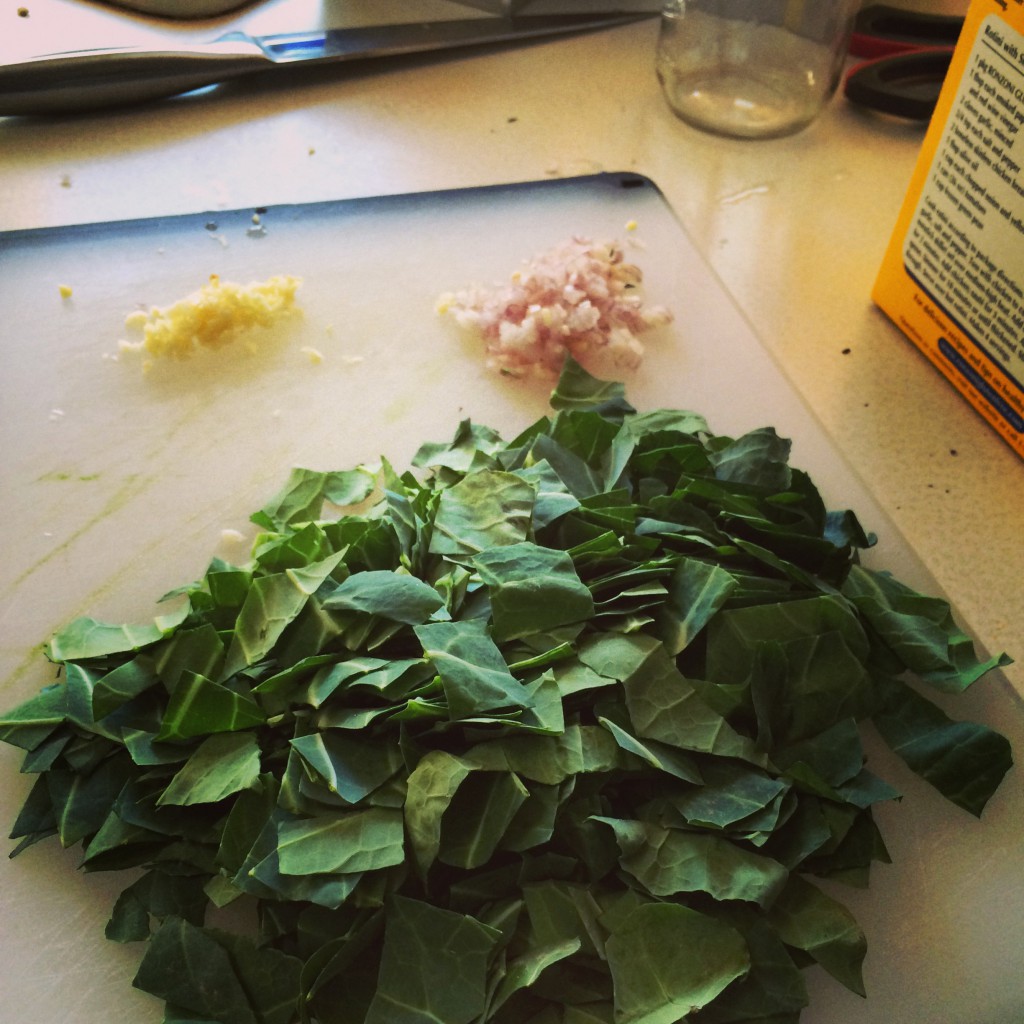
After the first few days post-LASIK, where my eyes felt like being perpetually stuck behind dirty contacts, hazy edges of everything and light that nearly pierced my brain in it’s brightness, I hadn’t experimented with just how my new means of vision would translate in the kitchen, and my need to clearly see my hands. Mike had brought home a box of gluten-free pasta that promised in large, persuasive text that it had a ‘White Pasta Taste!’ and my family would never know the difference. I craved a bowl of buttery noodles, covered in a thin layer of shaved parmesan, a salve for the body that was now rendered off in a new direction, brain and eyes communicating after a lifetime of silence. Everything was new. And I needed something old and familiar.
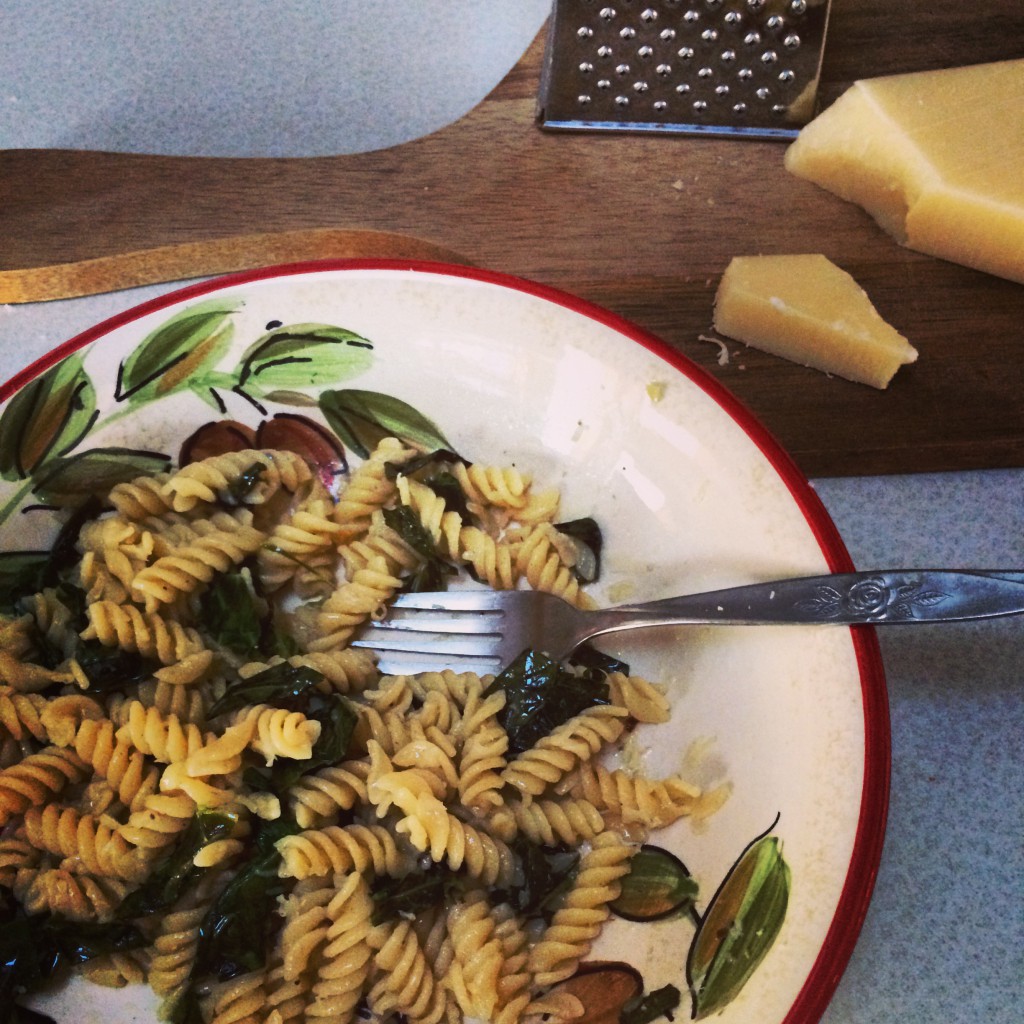
But this dish turned out to be anything but, yet, at the same time, it soothed immensely. It was buttery noodles. There was lots of fresh shaved parmesan cheese, just as I desired. But there were sautéed collard greens, a deeply burnished bed of shallots and garlic, and all of it was bathed in the deep umami of a thick anchovy fillet, melted in a puddle of olive oil. Skipping over the familiar, I added a dose of the here and now, trying to pull together two sides of my life that were now in conflict inside my head. I wish I could explain it better than that, but there’s so much to comprehend from this simple procedure that I never anticipated, so much emotion- being able to read the labels on the bottles in my shower, seeing the texture of the ceiling when I awake, pressing my cheek to my husband’s without the pinch of eyeglasses between us- the simplest of life moments that so many take for granted and never think about that suddenly are part of my life. I’m close to weeping every day at this wonderful, unfamiliar and amazing world. I can’t wait to leap in to a lake or pool this summer and come up with clear vision. I may break down crying at how great that will feel.
My boy wandered in the kitchen, dressed for his Wednesday night youth group at church and stuck his nose in the pot of pasta I was stirring together, clinging to thin sheets of collards and tiny chunks of allium, steam rising from the glistening spirals. His eyebrows rose in anticipation and he drew two forks from the drawer, and together we stuck a few noodles to the tines and lifted them to our mouths. I shaved the parm on his bowl, then mine, and we bent our elbows to the island in our kitchen, shoulder to shoulder and dipped our forks. This act of simple consumption with he and I is a need for both of us, to connect over a bowl of modest food, leaning together in companionable silence except for the clink of silverware, a swift moment to just be. It added to the familiar that my brain was seeking. He sighed as he scooped up the last noodle, moving it around the bowl to grab the last drops of oil and butter, the remaining bits of cheese. He smiled at me and leaned his shoulder in to mine, his gesture of thanks well received, another wave of the familiar among a week of new discoveries.
This pasta was so good; simple, deeply flavorful and crazy easy to make. If you haven’t experimented with anchovies in pasta dishes, I urge you to just try it, as they add immense depth.
Pasta with Collard Greens and Anchovy
1# pasta, cooked
1 thick bunch Collard Greens, stems removed, washed and rough chopped
1 medium shallot
2 cloves garlic
1 Anchovy fillet (or two, depending on size; I used Wild Planet White Anchovies, and they are BIG)
Butter and olive oil for cooking.
Parmesan cheese to taste
Cook pasta according to personal taste. While the pasta is cooking, heat a large, deep skillet and add a knob of good butter, along with a drizzle of olive oil. Sauté the shallot and garlic, stirring frequently, until golden in color. Add the anchovy fillet and mash with a spoon to break it up. Stir in the collard greens to coat, add about 1/4 cup of water, then cover the pan and reduce the heat to medium-low. Cook until the collards are soft, but still retain some texture.
Drain pasta, reserving a small amount of liquid. Add pasta to pot with collards and stir well to combine. Grind some black pepper over it, along with a few shakes of sea salt, stir some more and taste for seasoning. Adjust if you like. Add another drizzle of olive oil, or some more butter if you prefer, or some of the pasta water if it seems too dry. Spoon in to serving bowls and top with shaved parmesan cheese to taste. Grab a fork, and someone you love.
June 28th, 2012
| 21 Comments »
In moving past the continual consumption of meat with our meals, it brings to light an entirely new way of going out to eat, as I’m left wondering how up to date any restaurant will be with their meatless options. There are those places that soar, offering a wealth of meat-free entrees that dazzle, while others places rely on pasta dishes as their sole vegetarian fare.
Pasta isn’t bad, mind you. I do enjoy it. But these days, having just a pasta dish or two with vegetables as your meatless menu offering is pretty unimaginative for a restaurant.
But that being said, pasta has it’s virtues.
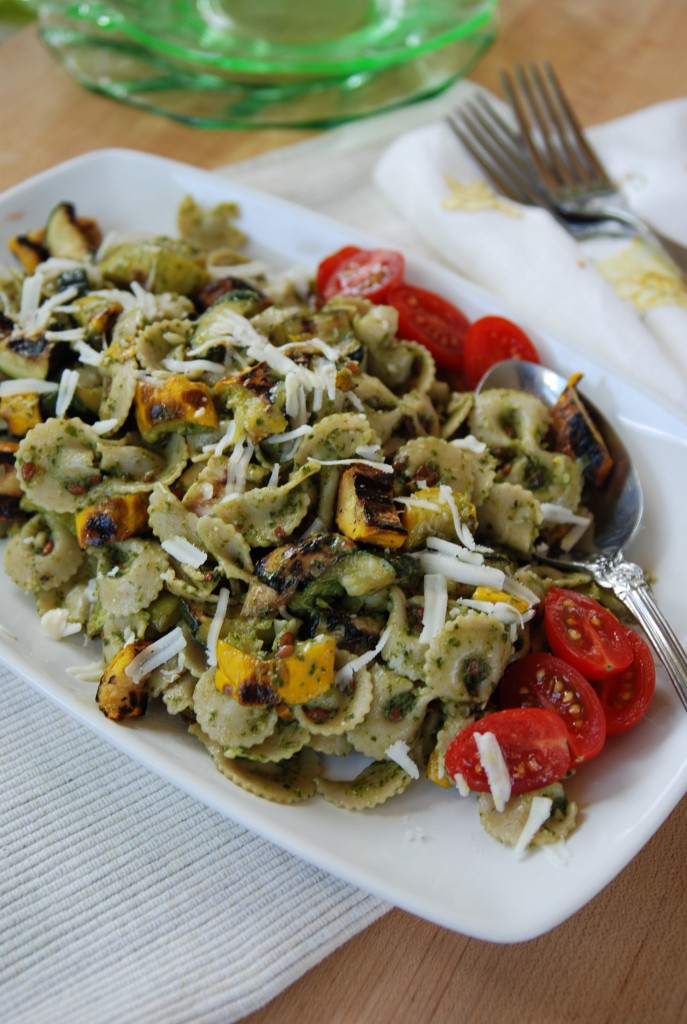
Hodgson Mills Pasta is running a recipe contest on Pinterest and I’m participating with this recipe. Are you on Pinterest? There’s a special page for Hodgson Mills that has all the recipe entries on it.
I’d appreciate a vote if you’re so inclined. There are some pretty nice prizes. You must go to the page linked above to vote. Pinning this recipe from my blog won’t count.
And Hodgson Mills was nice enough to offer $25 dollars of assorted pasta to one lucky winner from my blog. That’s a lot of pasta! All you need to do to enter is leave a comment on my blog stating your favorite way to prepare pasta (US residents only, with a valid mailing address, please) You have until Thursday July 5th to leave a comment and be entered for the giveaway. I will choose one commenter through Random.Org and contact you via email, so be sure to leave that information. Hodgson Mills will ship directly to you.
Do you love your pasta rich and cheesy? How about chock full of rich tomato sauce and italian sausage? Plain with simple garlic and olive oil? I’ve been enjoying Hodgson Mills whole wheat pasta with summer fresh pesto and grilled vegetables, and creating this recipe was a deliciously fun way to use up a huge box of basil that I’d been given. Food gifts are the best, aren’t they?
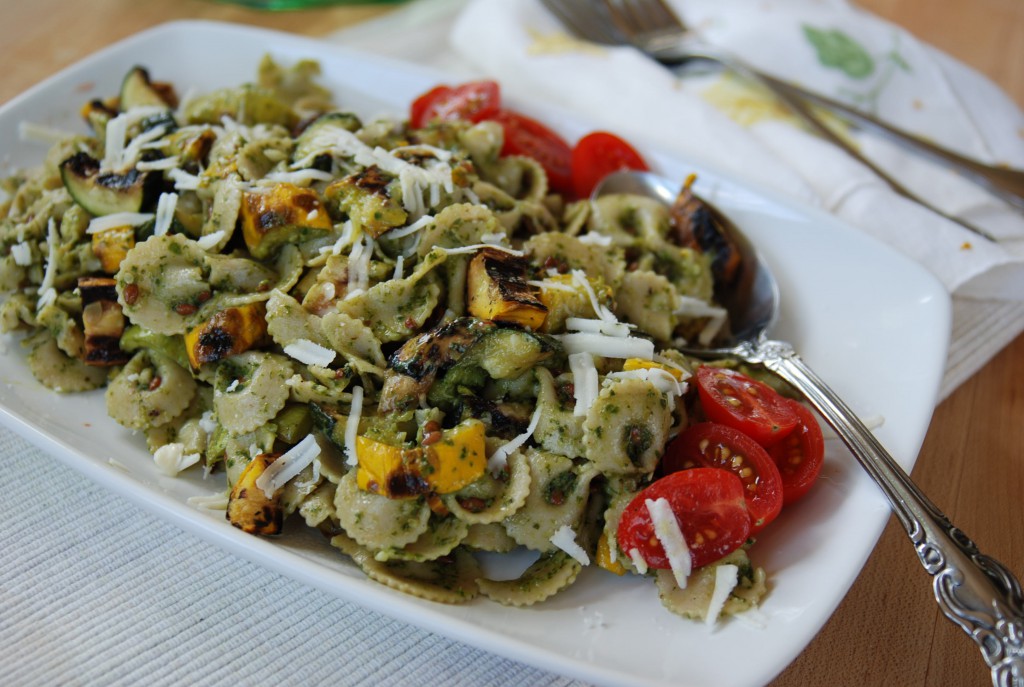
Summer Pesto Pasta with Grilled Zucchini
1-lb Hodgson Mills Bow Tie Pasta
2 medium zucchini
1/4 c. olive oil
2 T. fresh squeezed lemon juice
1 t. prepared spicy mustard
1 c. prepared pesto (or make your own from scratch, method included)
Fresh Cherry tomatoes, optional
Prepare zucchini:
Heat gas grill on high for 10 minutes. Just prior to cooking, reduce heat to medium-low and brush grill grates with canola or other neutral oil. Whisk together the olive oil, lemon juice and prepared mustard; set aside. Wash zucchini thoroughly and trim off root end. Slice zucchini the long way into three strips about 1/4″ thick. Brush with the mustard oil and place, oiled side down on prepared grill grates. Cook without moving for 5 minutes. Using tongs, carefully turn zucchini over and continue to cook until tender, about 7-10 minutes more. Remove from grill and set aside to cool. Cut zucchini in to bite sized pieces.
For the Pesto:
4 cups loosely packed basil leaves
1/3 c. olive oil
2 T. shredded parmesan cheese, plus more for finished pasta.
2 T. pine nuts (optional)
1 T. kosher salt
1 t. fresh cracked black pepper
Place all ingredients in the work bowl of a 2-quart food processor. Process in pulses until thoroughly combined, adding more olive oil if needed and scraping down sides as necessary. Scrape prepared pesto in to a bowl and press plastic wrap over the surface to prevent discoloration.
In a 6-quart stockpot, bring water to a boil. Add pasta and salt, if desired. Cook pasta until just al dente. Reserve one cup of the cooking water, drain pasta and place back in the stock pot. Add half the pesto to the hot pasta. Drizzle in a little of the cooking water and stir to combine, adding in a bit more cooking water if needed. Add more pesto if needed, along with the cooking water until it’s to your preferred consistency. Stir in the grilled and chopped zucchini and more parmesan cheese, if desired. Taste and season with salt and pepper. Chill pasta for up to an hour before serving, or overnight if desired. Taste prior to serving to adjust for seasoning, and add sliced cherry tomatoes for garnish and color.
March 4th, 2012
| 1 Comment »
This time of year is a hard one.

I seem to start slipping off the tightrope each February. Bored, restless, tired and too stunted by the dull landscape, I stand on the figurative ledge and think ‘Ugh.’ as I look around. The vertigo makes me twitchy, and thankfully, a trusted friend is there to pull me back and say ‘You know, you go through this every year at this time.’. I’m grateful for someone standing outside of me, who can rationalize this wandering mind, drawing it back to the reality that it’s just late winter and I could use some green and some color in my life.



Surrounding myself with a few hours of plant life, of colorful flowers, weeping ferns and a warmth that left me sweaty certainly helped a great deal, and it seems to become more important in the last gasp of winter to put sunny, warm foods in to the body, like an infusion of heat and sunshine that lights us up from the inside. Like this lemony pasta.
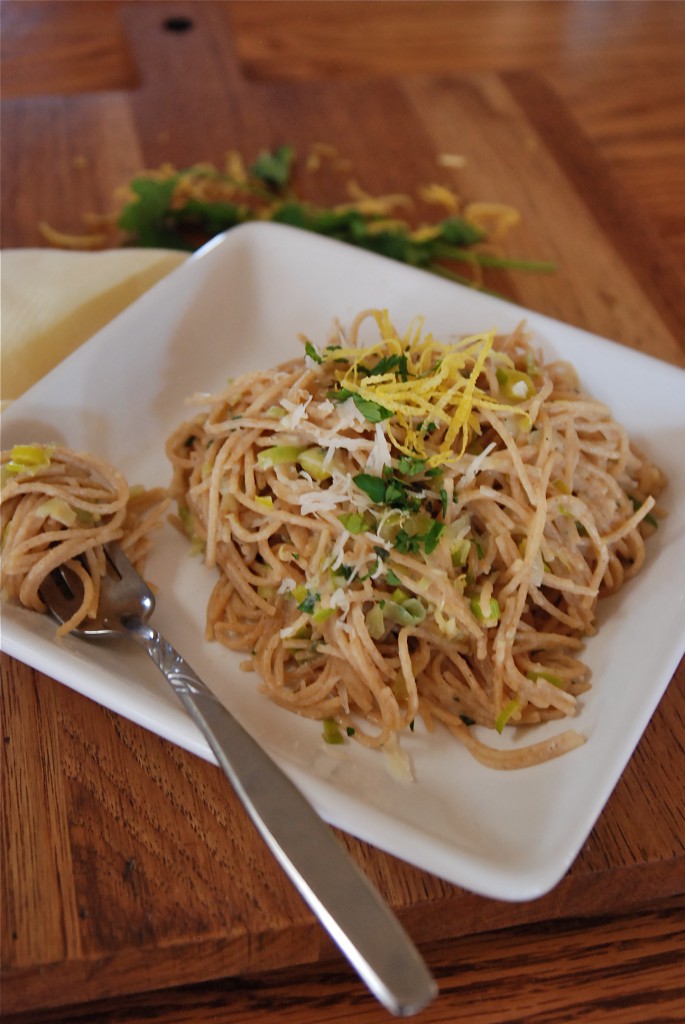
Eating anything with lemon in it is like ingesting sunshine, it’s so bright and engaging. This couldn’t be simpler to make, with a few leeks, a juicy lemon and a shower of fresh herbs, and parmesan cheese. I’ve done so much with lemons in my baking, like this Lemon Pound Cake, these intense Lemongrass Bars, and a delicious Lemon Ricotta Cookie, but adding sparkling citrus flavor to savory dishes has been few and far between, with maybe the exception of these exceptional Garlicky Lemon White Beans. That’s to an end though, after discovering this bright and lively pasta dish.
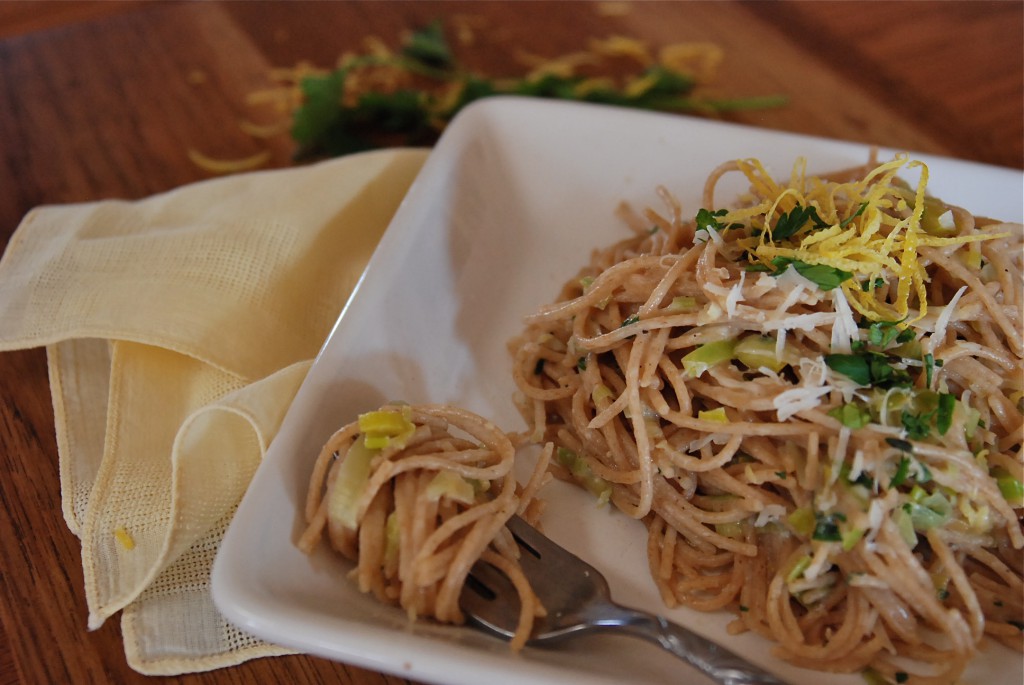
From the February issue of Eating Well magazine, resplendent with juicy lemon slices on it’s cover, this is a quick and easy recipe to put together. In the time it takes you to make a pot of pasta, you can have the leeks sauteed, ready and waiting. A few turns in the pan, with a splash of that ever-important pasta water and dinner is served.
Leek and Lemon Pasta
1# whole-wheat linguine or thin spaghetti
2 large lemons, plus lemon wedges for garnish
2 medium leeks (white and pale green parts only), thinly sliced and rinsed well
2 tablespoon extra-virgin olive oil
1/2 cup chopped flat-leaf parsley, divided
2 cloves garlic, crushed
1/4 teaspoon salt
1/8 teaspoon freshly ground pepper
3/4 cup finely grated Parmesan cheese, divided
1/4 cup snipped fresh chives, divided (I used thyme and it was delicious)
Cook pasta in a large pot of boiling water until just tender or according to package directions. Reserve 1-1/2 cups of the cooking liquid and drain the pasta in a colander.
Meanwhile, finely grate the zest from one lemon and squeeze juice from both lemons; set the juice aside. Pat leek slices dry. Heat oil in a large nonstick skillet over medium-high heat. Add the leek, the lemon zest, 1/4 cup parsley, garlic, salt and pepper. Cook, stirring frequently, until the leek is lightly browned and softened, about 6 minutes.
Add the pasta, 1 cup of the reserved cooking liquid, 1/4 cup of the lemon juice and the remaining 1/4 cup parsley to the pan. Cook, stirring constantly, until the liquid is mostly absorbed, 30 seconds to 1 minute. Add the remaining 1/2 cup liquid, or more lemon juice, if desired. Remove from the heat. Toss the pasta with 1/4 cup Parmesan and 2 tablespoons chives. Transfer to a serving bowl or bowls; sprinkle with the remaining Parmesan and 2 tablespoons chives and serve with lemon wedges, if desired.
Recipe in full, from Eating Well magazine, February 2012.
RECIPE NOTES: A simple reminder to yourself to catch the pasta water when draining it is to place a pyrex measuring cup in the bottom of your strainer when you put it in the sink. Pour some of the pasta water in it, set it aside, then drain the pasta completely. Another method, which I prefer, is to remove the cooked pasta from the water with tongs and add it directly to the skillet. It takes a bit of timing to get it right, but instead of draining all that beneficial starch away, it clings to the pasta and helps to create the pan sauce needed.
This dish would be wonderful with a broiled mild fish, such as Cod or Tilapia, some seared Scallops or Shrimp would also taste good. If you like chicken, a good lemon-herb rub and a run under the broiler would make a perfect accompaniment to this pasta.
February 10th, 2012
| 4 Comments »
There is something so perfect about a pot of soup, one that steams and seems to sing from the stovetop, humming it’s warmth throughout my kitchen, through my skin and right in to my bones. I feel the need for soup, sometimes as deep as the roots of my hair and permeating outward, and as any good Midwestern girl knows, when the cold winds scour you down and the light is so flat and gray and weak that it makes you weary and drawn, then soup, in all it’s aromatic glory and flavor, can be a shot of lifeblood that runs through you, chasing the chill away.

Soup has but a few simple secrets to making it shine, such as taking some time to caramelize the vegetables to form a flavor base, a good broth or stock to add more depth and a shot of love, really, to not rush the process. But good soup really starts from need. Or craving and desire.
I used to not be all that good at making soup, mostly because I just didn’t understand why a recipe that looked so simple could often turn out so darn wrong. I wanted depth, a rich flavor that penetrated the spoon and it’s contents, making it something so much more than broth and vegetables. All I really needed was a bit of patience, a lot of practice and tad more salt. Don’t be afraid of a shake of salt over that simmering pot, as it is the one ingredient that can transform a simple pot of soup to one that shimmers it’s warmth right down to your toes.
This Minestrone soup, as all Minestrone soups go, really has no clear outline, no real etymology. It creates itself for the most part, out of what you have on hand, and what you like in your soup. Or, like me on this particular cold January night, it leapt from under my hands out of sheer need. I couldn’t get warm, couldn’t shake a chill that had settled in my core like a wicked internal frost. Somehow, this chill and it’s accompanying rattle in my brain sounded like it was saying, over and over “Make Minestrone!” and I moved, on automatic it seemed, from fridge to stove to cupboard, seeking and searching ingredients. There were the green beans languishing in the drawer and in dire straits, there was Pomi tomatoes (my favorite packaged tomato- so amazingly fresh and flavorful) and there were thick, deeply orange carrots, fat tear-jerking onions, a partial box of orzo, a few zucchini beginning to look slightly sorry for themselves, just enough kale, a bounty of fresh oregano and parsley. And while the fragrance filled the house, and the soup simmered it’s coherent and rhythmic blup-blup-blup on the stove, a quick search for dunking material in the freezer yielded a container of croutons, spiked with herbs and olive oil, that I’d made from a loaf of stale semolina bread. Did I mention another key ingredient to perfect soup just might be a touch of serendipity?
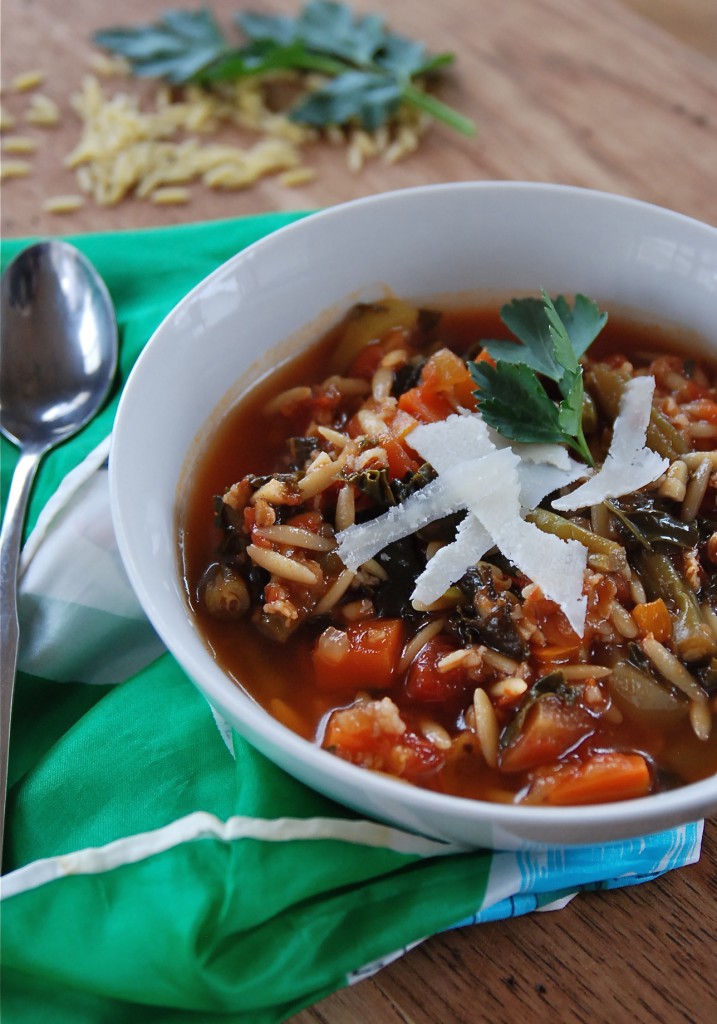
Minestrone requires little of the hard and fast rules; you add what you’ve got, really. What is in season, what is available, what it is you like. It needs a good tomato-y base, without a doubt. But beyond that, it lives for your interpretation. Thick or thin, meat or not, one, two or three vegetables or a whole produce aisle of them, pasta, legumes or rice- it’s all up to you. This version that served to warm my very cold, rattling bones on that damp, chilly night made light of too many singular remnants from the fridge; bits and pieces of plans that maybe fell through or were forgotten, or the one too many of any vegetable that hadn’t been used up yet. It had oceans of freshly chopped oregano and parsley tossed casually over it all, with thick shavings of sharp parm-reggiano. It was like planning a party at the last moment, not so confident of how it will all turn out and right in the middle of it, you realize that everyone in attendance has created an impeccable presence that elevates the whole of it to something utterly sublime. Well, that was my Minestrone that night; a delicious party in a stockpot, gathered with fingers crossed. My intensely perfect Minestrone.
Rounding it all out were the crunchy croutons, oiled, herbed and perfect for soaking up the broth. Beyond that, my perfect soup needed little else but a spoon, a quiet table with two smiling handsome faces, because no day in my life is complete without it ending right there, with them. The darkness settles, chasing out the light with violet and gold tones. The first spoonful I lift easily helps me cross the threshold from day to night, pushing the cold away, warmly coursing through me. There is a sigh, with half-closed eyes, a look and a feel that says “Perfect. This is just what I need.”
Kate’s Minestrone
1 large onion, diced
3 carrots, peeled and diced
3 celery stalks, with leaves, diced
4 cloves garlic, minced (adjust to taste, I am a garlic lover)
2 small zucchini, peeled and diced
1/2# fresh green beans, cut to 1/2″ pieces
1 bunch fresh kale, rough stems removed and chopped (sub chard, collards, or spinach)
1 32-oz pkg Pomi Tomatoes (use equivalent of your choice)
1/2 c. Orzo pasta (use small pasta of choice)
1/4 c. bulgur (optional, but I like the heft and nutrition it adds)
1/4 c. fresh chopped parsley and oregano (basil and thyme are also good)
Parm-Reggiano shavings
In a large stockpot, heat a small amount of oil and add the onions. Cook over medium heat, stirring occasionally, for about 5 minutes, or until the onions are opaque. Add the carrots, celery and green beans and cook, stirring, until the vegetables begin to brown a little, maybe 10-15 minutes. Moderate the heat to prevent them from scorching.
Add the garlic and a pinch of kosher salt. Stir to incorporate and cook for a few minutes until it’s wonderfully fragrant. Add the zucchini and the tomatoes and a quart of broth or water. Bring to a simmer and cook until the vegetables are tender enough to pierce with a fork, but not completely soft.
Add the kale, the pasta and the bulgur, if using. Depending on what pasta shape you use, cook until the pasta is al dente. Taste the soup and season with salt and pepper. Make sure the pasta is cooked, but also remember that it will continue to absorb liquid as the soup sits.
Ladle soup into bowls and top with a sprinkling of the fresh herbs and some shavings of cheese. Serve with a good bread, if desired.
RECIPE NOTES: This soup is wide open to interpretation, and can be modified in a multitude of different ways. Brown some good sausage and use the fat rendered to cook the vegetables for an added punch of flavor. This was a favorite way to make this soup back in my meat eating days.
Legumes can be added to this as well, and most Minestrone soups have them. Use a good quality white bean, such as Great Northern or Cannellini. Chickpeas would also be a good option.
As is the case with most soups, it develops a lot of flavor as it sits overnight in the fridge, but it will also absorb a lot of liquid in to the pasta and the bulgur (if you use the bulgur). Adding a little water to the soup before reheating will help loosen it.
Linking up to Soupapalooza 2012!!
“Come join SoupaPalooza at TidyMom and Dine and Dish; sponsored by KitchenAid, Red Star Yeast and Le Creuset”
May 16th, 2011
| 3 Comments »
If you recall, Whole Foods invited me to participate in a 28-day challenge based on the Engine 2 eating plan (I hate the word ‘diet’ and won’t use it) that calls for a 100% plant based way of food consumption. It goes so far as to exclude fats and salt as well. My take on it was to kick out the meat. We eat more than I want mostly because my teenager really loves meat, but Mike and I were getting tired of it. And it’s the costliest item in our food budget. As well as going meat-free, I’ve cut out my beloved butter, the only dairy I consume and I’ve cut down on oil usage and tried to avoid salt.
So… two weeks in to this eating plan, and what’s been happening?
#1- The teenager is a bit miffed. ‘What do we eat!?’ he says with emphatic resignation. But the meat free meals that leap from the stove top have him devouring his portion with gusto. I’ve given in to his need for meat on occasion, utilizing small amounts of chicken for him, and having a meal with shrimp. But this boy is not suffering. No no…..
#2- My pants fit better. And I can get myself in to two pairs of jeans that I haven’t been able to wear since last summer. Some of the belly fat is disappearing. I think my face looks thinner. I have a bit of a way to go with reaching what I think is an ideal weight for me, but this eating plan wasn’t about losing weight at all. I needed maybe a 10 pound drop at most and when I started the plan I had already lost about 5 of those pounds. For me, this is about eating more healthy foods and feeling better.
#3- This is a big one. Several months ago I started experiencing symptoms of menopause, mostly in the way of hot flashes. They had become really intense, and a constant in my day. They’d cover my neck and shoulders, resulting often in getting so overheated that the underside of my hair would become very damp. And the worse ones came at night, radiating through my pelvis and hips and down my legs, causing me to kick off the blankets to cool down. I’d fall asleep, then waken later absolutely freezing. This night cycle went on and on, and it wasn’t helping my sleep patterns at all. But since giving up meat consumption, the hot flashes have fallen off dramatically, the lower body ones disappeared completely and the consistency has been reduced to only a few light ones each day, mostly very manageable. No more damp hair!! And this happened within days of giving up meat. It’s been completely unexpected but such an amazing finding. If I’d known giving up meat would help this, I would have done it ages ago. Another physical aspect that has fully disappeared when meat left my meals is any kind of stomach upset. I’ve been blissfully comfortable for the past two weeks with no indigestion, no upset or gas and no bloating.
#4- I miss my popcorn fix, but that’s about the only food I really want to be eating that I’m not. I simply can’t eat popcorn without melted butter and salt, and at least once a week I would pop a big bowl of it and crunch crunch crunch my way through, sighing in contentment, slurping buttery salty fingers and smiling through eyes half closed in a popcorn induced ecstasy. I think I love the sensation of it, the textural pleasure of eating something so noisy, and so flavorful. I don’t really miss meat, nor crave it. See #3. But I really miss my popcorn.
What this plan is doing for me that I do love is really giving me a lot more reasons to look at the foods I eat and make the best possible choices. I was out for an evening with some friends and had to take a good hard look at the menu options for something that fit this challenge; thankfully I had three choices to pick from, all of them acceptable. Eating out may be more challenging, and thankfully we don’t do it that often. But we’ve also been eating pretty mindfully prior to starting this plan. This gives us a reason to take it one, or ten steps further.
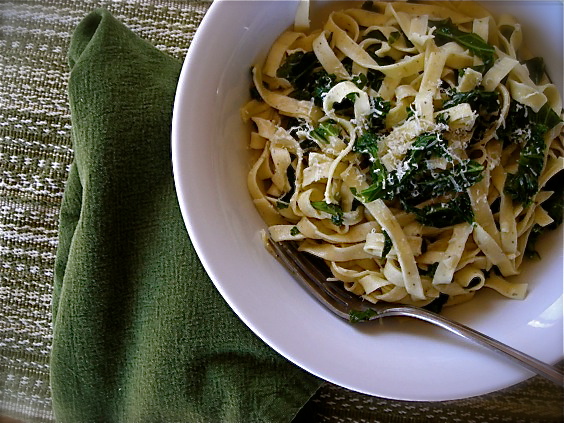
This pasta dish is halfway acceptable for the eating plan, in that it’s loaded with braised kale. The fettuccine isn’t exactly E2 friendly, but it was what I wanted to eat after an intense afternoon of gardening. Sometimes you’ve just got to allow for a dish that nourishes the soul as well as it fills the belly. I really struggle with any aspect of eating that deprives us of what we really want. If I really want popcorn, I’m going to make it. If I want a juicy bratwurst, I will grill one so that the skin splits and it sizzles in delight, pressed between the edges of a perfect bakery roll and slathered with the best mustard in my fridge.
But at the same time, what I put in this body of mine, the only one I’ve got, really does make a difference in how I feel, the energy I have and the way I get through my day. I’ve felt it, noticing when I don’t eat healthy foods and had to force myself through the side effects of poor eating; the sluggishness, the lack of energy, the belly aches or heartburn. I’m not harming myself by consuming a grilled piece of chicken, or some perfectly cooked shrimp. And I’ve found that by really paying attention to making 90% of the foods I eat be healthy, plant based foods, it really has made a huge difference in how I feel. Should I go to 100%? Should I give up the oils, the salt? Should I? For me, this alternative plan makes sense. I like the results, the way it makes me feel and the relative ease on my pocketbook. And if in just two weeks it’s got me thinking of even more ways to have healthier options in our meals then I feel it’s achieved something great.

Like I said about this dish, it fit what I really wanted to be eating, when the hunger became so great from all the activity that I’d done I found myself with shaky hands and that trembly feeling of a deeply low blood sugar. I needed about 20 minutes to gently cook the kale until it was silky soft and lush, and only a few minutes to cook the fresh dried fettuccine I had on hand. A toss together in the deep skillet with a few dashes of lemon juice and some rosemary Manchego cheese I had on hand (totally not E2 friendly, but ah well…..) and I sat down with a deep bowl, a thick heavy fork and a content sigh. It had been a long day, but a full one, one with accomplishments and a lot of good spring sunshine. Eating a terrific and healthy meal was like placing a fancy top hat on the end of this day, and swinging off with a jaunty step.
Braised Kale with Spaghetti
1 pound lacinato kale (about 2 bunches), large center ribs and stems removed, cut crosswise into 1/2-inch slices
3 tablespoons olive oil, divided
1 medium onion, finely chopped (about 1 1/2 cups)
8 large garlic cloves, thinly sliced
1/2 pound spaghetti
2 teaspoons fresh lemon juice
Finely grated Parmesan cheese
Rinse kale. Drain; transfer to bowl with some water still clinging.
Heat 2 tablespoons olive oil in heavy large pot over medium heat. Add chopped onion and cook until soft and translucent, stirring occasionally, about 6 minutes. Add sliced garlic and sprinkle with salt; cook until onion is golden brown, stirring occasionally, about 5 minutes. Add kale and remaining 1 tablespoon olive oil and toss until wilted, about 3 minutes. Cover pot and reduce heat to medium-low. Continue cooking until kale is very tender, stirring occasionally and adding water by teaspoonfuls if dry, about 20 minutes.
Meanwhile, cook spaghetti in medium pot of boiling salted water until tender but still firm to bite, stirring occasionally. Drain, reserving 1/4 cup cooking liquid. Add cooked spaghetti to kale mixture in pot. Add lemon juice and 2 tablespoons reserved cooking liquid; toss to combine, adding more liquid by tablespoonfuls if dry. Sprinkle spaghetti with grated Parmesan cheese and serve.
Original recipe from Orangette.
KATE’S NOTES: I made this with regular curly leaf kale, and used a 16-oz bag of gourmet basil fettuccine in place of the spaghetti. I did not use onion, and only used 3 cloves of garlic; it was plenty! Do make sure you give the kale a nice slow simmer. The result is so tender and delicious that it’s positively addicting, and well it should be. This recipe is what turned Molly’s mind away from hating kale and I’m pretty sure if you let it, it will do the same for you.
November 18th, 2010
| 5 Comments »
There’s a lot of cowboy in me. Not the horse-ridin’ spur-wearin’ giddy-up-ing cowboy, but the kind that understands ‘Cowboy Cooking’ as a necessary culinary term.
Most people these days better understand the term ‘Iron Chef’ though, thanks to the ubiquitous presence of the Food Network. Cowboy cooking, or Iron Chef-ing is where you take a whole bunch of ingredients and come up with a dish that is nothing short of fantastic. It’s a skill that has served me well in my kitchen.
This roasted vegetable pasta dish was a stellar example of that. It’s from last winter and was a repeated entree in our kitchen for the remainder of the season. All you do is roast up a pan of your favorite vegetables until they are fragrant and soft, then process them in a food processor to a chunky sauce. Mix them with a hefty pasta shape, add some grated parmesan and grab your fork. It works equally well to just toss them with pasta as is after roasting.
The sauce is versatile enough to also be used as an appetizer, topping crostini or another sturdy base.
And uh yeah….. ew; this photo is NOT my favorite, yet it’s what I get trying to photograph food in Minnesota during the month of February. Ugh. Sorry.

It really tastes FAR better than this looks. I promise! Yee haw!! Let’s get cookin’!
Roasted Vegetable Pasta
1 medium eggplant, cubed
1 medium yellow onion, cut into eighths
1 red pepper, seeded cored and cut into large chunks
1 pint grape tomatoes, halved
4-6 cloves garlic, rough chopped into large pieces
Olive oil
Salt and pepper
1 # rigatoni
Fresh parmesan cheese
Chopped kalamata olives
Place vegetables into a large bowl. Pour about 1/8 c. of olive oil over them, salt and pepper and maybe some dried seasoning of your choice. Toss to coat. Place on cookie sheets and roast in a 400-degree oven for 25-35 minutes, or until vegetables are soft and fragrant. Gently stir once during the cooking.
Cook pasta to al dente. Drain, reserving about 2 cups of pasta water and keep pasta warm. Place roasted vegetables in food processor and add a cup of reserved pasta water and 1/8 c. olive oil. Process until mixture is chunky, scrape down sides and process to desired consistency. If mix is too thick, add some more pasta water. You want it to be spreadable but not drippy, thick but not gloppy.
Toss vegetable mix with warm pasta. You may not need it all so scoop accordingly. Toss to coat pasta, add in kalamata olives (if desired) and parmesan cheese. Season with salt and pepper. Serve hot.
And remember when I recently talked about that yummy Panko Crumb topping? Hello, and giddyup …..it works perfect here.
November 14th, 2010
| 2 Comments »
The snow stopped and we received about a foot of wet, heavy white stuff. I was pretty grateful that it arrived on the weekend and about our only need to accomplish was cleaning off the driveway and sidewalks. It was so nice not to have to go anywhere. We spent some time knocking the thick clumps off neighbor’s trees and bushes as it was so heavy that it was bending them nearly in half. We also saw plenty of downed tree branches today on our way to church.
The down time afforded us an opportunity to work up a new ever-changing header for the blog? Like it???
Tomorrow, hopefully, I will have the results of the MRI. Kind of curious, trying not to be concerned that anything is seriously wrong. Pretty doubtful on that.
About three years ago, I posted a short little blurb on here about a delicious buttery, crunchy topping that I love to eat on buttered noodles. I almost didn’t even post it because I thought it was the silliest, most mundane thing I could even conjure up, but it turned out to be one of my more steadfast search terms that people use to find my blog. Who would have thought that ‘Buttered Noodles’ needed to be searched?
At any rate, this yummy herbed topping is delicious and simple, and adds the perfect touch to not only buttered noodles, but mac&cheese and all other forms of pasta dishes you can come up with.
Herbed Panko Topping
2 T. butter
2 T. olive oil
1 c. Panko breadcrumbs
1 t. garlic powder
1 t. onion powder
1 t. dry basil
1/2 t. dry mustard powder
Salt and pepper to taste
Melt butter and oil in small saute pan. Add crumbs and toss to coat. Add in remaining seasonings and cook over medium-low heat, stirring continually until crumbs are browned and fragrant. Remove from heat and spread on a plate to cool. Add in parmesan/asiago type of cheese if desired. Sprinkle over drained pasta, and toss to coat.
Kate’s Notes: Once the crumbs are nicely browned, you must take them out of the pan to cool. If you leave them in the pan they will burn. Trust me. You can mix up the dried herbs you add as per your individual tastes. Use all butter too, or all oil. I like the combo of both. These keep in the fridge for about a week or so, I’m guessing anyway. They tend not to last that long around here.

June 8th, 2009
| 4 Comments »
Maybe I was a rabbit in another life. Or maybe it’s just my normal summertime affliction, but greens have dominated my meals as of late.
What fuels this obsession, and it can certainly be called one, is the availability of the ‘live’ lettuce heads my grocer has started carrying. I found these last summer and the love affair was ignited like an inferno; a big bunch of varied lettuces are packaged with the root ball intact. They can be planted and grown at home, or like I do, simply chopped off at the root, washed and held in the fridge. The amount of lettuce one gets in these offerings is grand, the quality is terrific and the price is exceptional, a bargain if there ever was one. I’ve bought two at a time and happily dug into their depths for countless meals, relishing the ease, the taste and the light fare. The bonus is that it’s a locally grown product by Minnesota’s own Bushel Boy.
Still, I’m chomping at the bit to get into Market season, where farmers by the score sell buckets of fresh lettuces for insanely cheap prices. A dollar gets me a five-quart buckets worth of fresh lettuces, almost more than I can manage, but that never seems to stop me. Once June is ever-present and the weather beckons me to other options, ones that don’t include standing over a stove, having fresh greens in the fridge gives me endless options for meals. I’m satisfied to have a plate of leafy goodness that hides all sorts of other crunchy vegetable options, a grain and legume for protein with a simple squeeze of a fresh lime and a dash of balsamic, and maybe a piece of chicken for Griffin to help his carnivorous cravings. With these offerings, and a few decent salad dressings, my young man surprised us all recently, including himself, when he ate a grilled chicken salad with amazing gusto and exclaimed “That was the best salad I’ve ever had. And I never expected to use the words ‘best’ and ‘salad’ together ever!!”
Well, neither did we, and it was an awfully nice thing to hear.
So it was with great anticipation that I awaited the start of one of my favorite local satellite Farmers Markets and drove towards it with excitement. Imagine my disappointment when the normally over-crowded parking lot where it is held instead was home to just about half a dozen vendors, with only one selling any type of green stuff. I felt like a slowly deflating balloon, but shouldered on, purchasing a sackful of organic spring greens, spinach and radishes. At least it was a good start, and while I was heading back home with my goodies, the sack of spinach, crammed full of dark green curly leaves, gave me the idea of making Spinach Pesto and then dinner was born.
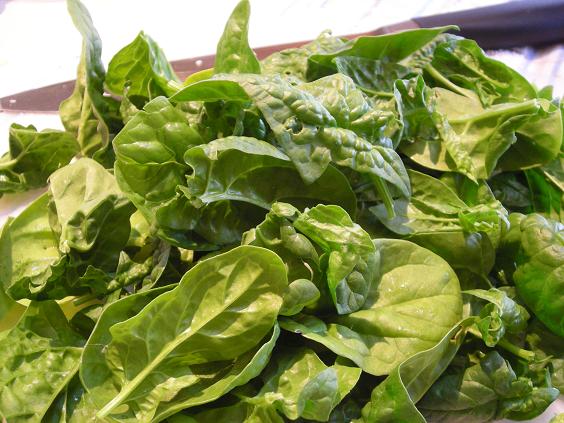
Pesto is a favorite around here, well- of the adults anyway. A few summers in the past, I had a garden bounty of basil that I turned into approximately 20 cups of pesto that I coveted in the freezer for months to come. I’ve been slow to experiment with other forms of pureed greens, but no more; this spinach pesto, combined with some remaining roasted red peppers that I found in the fridge, was so light, delicious and flavorful that now the craving for pesto, in any form, can be squelched with nary an effort outside of cleaning a bounty of my favorite leafy green.
 
And it turned a plain box of pasta into a superb weeknight meal.
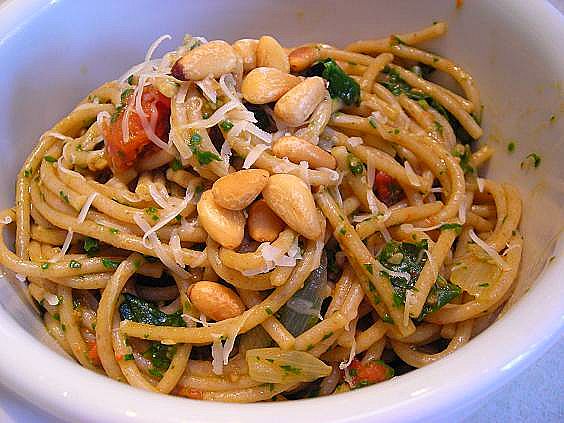
Spinach Pesto
by Kate
4 c. washed spinach leaves, stemmed
1/3 c. olive oil
3 T. toasted pine nuts
1 clove fresh garlic, chopped
Place all ingredients in a food processor and process until smooth, scraping down sides as needed. This pesto can be frozen for quite some time with only minimal loss of flavor. Do not add cheese to pesto if planning to freeze, otherwise, add to taste your preferred hard cheese.
For the Pasta-
Heat water to cook pasta.
I diced two ripe tomatoes and sliced a medium shallot. Sautè the shallot in olive oil, in a deep sided pan, until soft and starting to turn slightly golden. Reduce heat and add tomato, cooking over low heat until it begins to break down only slightly. Stir minimally.
When the pasta is ready, lift all the pasta with tongs straight from the cooking water and into the saute pan. Stir to coat with the tomato mixture, then spoon in about a half cup of the prepared pesto. Using a little of the pasta water, thin the pesto slightly and toss to coat. Add more pesto if so desired. Top with grated cheese and toasted pine nuts and season to taste.
I stirred about a cup of chopped spinach leaves into this as well for a little more color and texture.
Simple Tip of the Day:
When you use spaghetti for a pasta dish, do you break apart the strands before placing them in the boiling water? Does tiny shards of broken spaghetti fly all over the kitchen?
Try this instead:
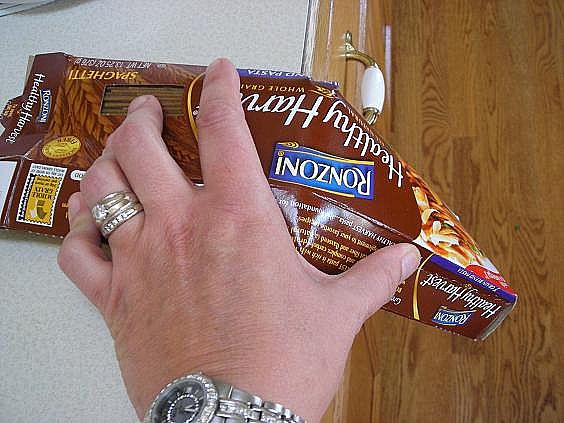
Leave the pasta in the box and bend the box over the edge of your counter. All the broken pieces stay in the box, eliminating the annoyance of finding them scattered around your kitchen for days to come. Also, if you salt your pasta water, pour the salt directly into the box with the pasta while you wait for the water to boil. That way, you’ll never forget to add it.
Pesto Magic!
Pesto is so endlessly versatile. Have you ever stirred pesto into burger meat? It’s one of my favorite ways to use it. The oil helps to keep the meat moist and it gives the finished product huge flavor. Griffin won’t eat pesto on pasta, but when I turn the remains into a grilled and fragrant burger, he spares no restraint in consuming it without question.
Pesto is also wonderful in a grilled cheese. We didn’t get around to utilizing this method with the spinach pesto this time, even with wonderful Jalapeno Cheddar bread available as a base, but in the foreseeable future, I’m pretty certain this will be dinner.
Spread some pesto on slices of french bread, a pocketed ciabatta or crusty semolina sesame and sprinkle a little grated hard cheese over the top. Try something different than parmesan or asiago- maybe manchego?- and then place the slices under the broiler for a few quick minutes. Watch carefully! This is an excellent appetizer. Thick slices of fresh tomato can also be spread with pesto and cheese and broiled to a sizzling snack.
Roasted vegetables get a nice enhancement from being served with pesto, especially potatoes.
Pesto salad dressing is wonderful. A tablespoon or two can be added to your standard oil/vinegar mix, or thinned slightly and simply tossed with your greens.
May 10th, 2009
| 5 Comments »
Life isn’t simple anymore. Not that this is a shock to anyone with an adult’s perspective. It seems that everything has gotten so much more complicated, and while we burst through life determining what path to take that is right for us, we are constantly faced with decisions and truths that require a ‘turn on a dime’ change of direction. It’s just not like when we were kids.

Of course, this isn’t a bad thing either. It’s nice to look at our past and see where we’ve ‘grown up’ even if, somewhere inside us, we still are surprised at the face that looks back from the mirror. I still can feel like I’m 12 again, or 24, or 30 and a brand new Mom. Of course I wish that I could still run barefoot from June to September, the sun hot on my skin and nothing more pressing in my day except where the next adventure would take root; I think about Kool-Aid, Popsicles and A&W Root Beer with a hard scoop of vanilla ice cream floating in it. I think about one-room air conditioners, the smell of bed linens fresh off the clothesline and how it seemed so perfect to take a peanut butter sandwich outside to the backyard for a picnic. And while all of this speaks more to the carefree days of childhood and what I find I can no longer freely indulge in, it’s more than just a nostalgic turn; I think I just yearn for a time when I was blissfully unaware that life existed outside the realms of my neighborhood. With all the gloom and doom present in our daily media, it’s no small feat to try and close it out. And while I can grasp my adulthood fully with both hands and move ahead with the changing world, there still are times that I want something that reminds me of simpler days.
Not too long ago I posted about finding plenty of nostalgia in a perusal of food blogs, and it got a conversation rolling with Jamie and Kristen about foods from our past. Kristen especially tickled me in a discourse we had over cream soups and some of the dishes we used to make with them, and part of what we talked about was that although these foods often have good memories attached to them, they aren’t all that healthy. Looking around me in the grocer, I had to wonder if it was possible to bring them back with less guilt, and possibly more flavor.
The ubiquitous Tuna Mushroom Pasta was a standard from my childhood; macaroni, canned mushrooms and tuna, cream of mushroom soup and a crush of potato chips over the top was a mainstay for dinner. No one really went “Ooooooh!!!” whenever it was presented, and I recall a time when I clearly told myself I would never eat it again. And in that representation, I never did.
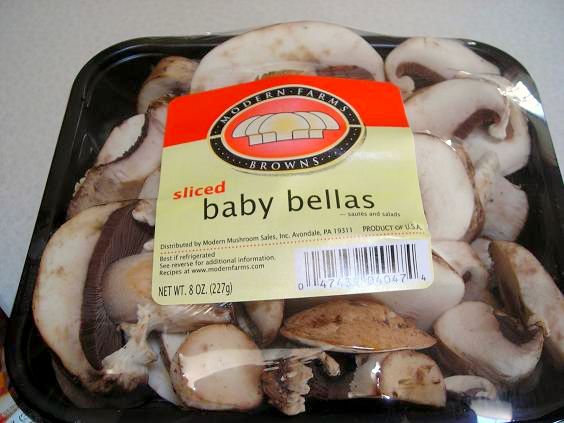 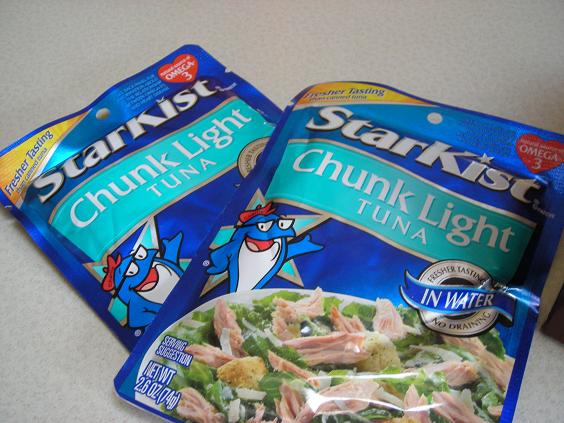 
One good thing about following the flow of life is watching your food mature around you. I’m glad to be far away from the foods of my past, although it’s nice to think I can recreate them, but better. And more flavorful.
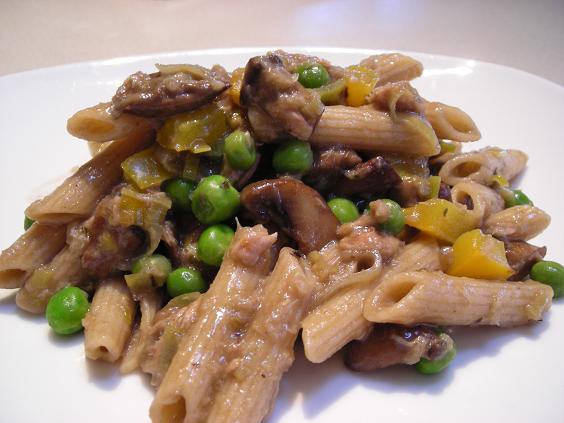 (Not exactly the Beauty Queen of Cuisine…..but oh so delicious!) (Not exactly the Beauty Queen of Cuisine…..but oh so delicious!)
No one is chained to Campbells soups anymore; Amy’s Soups has a lovely creamy mushroom soup, Health Valley Organics makes a completely natural line of cream soups, and then there’s my favorite- this Portabello Mushroom soup from Imagine Natural Creations. When the desire strikes for a meal that not only satisfies my need for a little nostalgia, but also will bring smiles to both Mike and Griffin- who absolutely LOVES this dish- this is where I turn; better ingredients, and a more sophisticated method.
 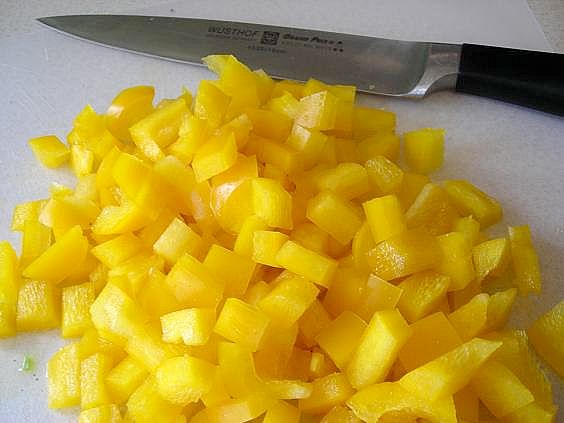
Kate’s Mushroom Tuna Pasta
1# dry pasta, cooked to taste
1 pkg. Baby Bella mushrooms
1 large leek, split and washed, sliced very thin
2 garlic cloves, minced
1 yellow pepper, chopped
1-2 3-oz pkgs Tuna (or other tuna of choice)
1 16-oz container Imagine Portabello Mushroom soup (or equivalent)
1/2 c. frozen peas
Butter and olive oil for cooking
Worchestershire sauce (optional)
Other optional add-ins: Toasted seasoned bread crumbs and grated parmesan cheese.
In a medium sized skillet, warm approximately 2 T. olive oil and 2 T. butter and add leek, cooking for about 15 minutes over medium heat, stirring regularly. When soft and beginning to brown in spots, add in yellow pepper and cook for 5 minutes. Stir in garlic, reduce heat to low and cook, stirring occasionally for about 5 minutes. Stir in peas, cover and keep over low heat.
In a separate pan, warm 4 T. of butter and 2 T. olive oil, add mushrooms and cook over medium-high heat, stirring regularly until mushrooms begin to release their liquid. If using, at this point add about 2 T. worchestershire sauce to mushrooms, along with a generous grind of black pepper. Stir to combine and continue to cook, allowing mushrooms to sear and brown.
Drain pasta, reserving about a half cup of pasta water, but don’t shake off excess. Return to pan and add in soup, tuna, the leek mixture and the mushrooms. Stir to combine. Add in some of the pasta water if the mix is thick. Season to taste with salt and more fresh ground black pepper.
KATE’S NOTES:
This method, while a bit futzy, produces a very flavorful end result. By no means is it carved in stone. I do heartily recommend a separate pan for cooking the mushrooms, solely for the flavor it will impart, but in a pinch you can cook all the vegetables together. Regular chopped onion is fine too, it seems lately I’m kind of on a leek fix. Skip the butter if it isn’t your thing.
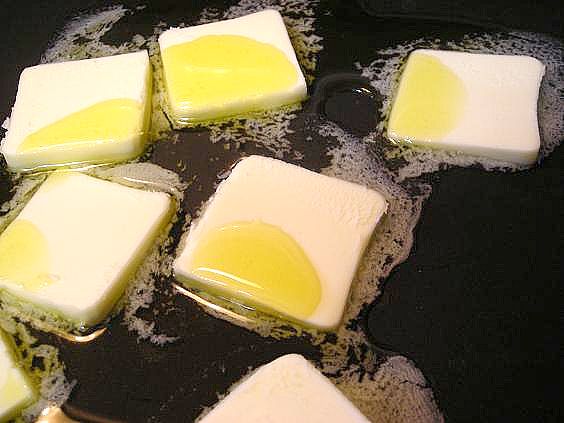
My love for toasted bread crumbs knows no boundaries. I prefer Panko for this application, reserving the bread crumbs I make from scratch for use as a filler or bond. I mix about a cup of Panko with melted butter and some olive oil, then add in a multitude of dry seasonings such as dried basil, garlic and onion powder, fresh ground pepper, maybe some dried mustard and then heat them gently in a pan, stirring continually, until they are fragrant and browned. Be sure to remove them from the pan when they’re done or they will burn. They keep in the fridge for a while, although I’ve never determined exactly how long because I make up excuses to eat them.
February 11th, 2009
| 5 Comments »
Admittedly, I like to break convention. I’m not one to conform to stereo-typing, I don’t mold myself to any expectation and I refuse to adhere myself to a certain role. At home, I’m just as easily found outside shoveling, chopping ice on our north-facing driveway, spreading mulch or digging a hole for a new garden plant as I am in the kitchen whipping up something delicious. I don’t think in terms of ‘mans work’ or ‘womens work’, and while we do have some things in our house that may fall into those categories, I don’t think that any job should be defined by your gender. I would have never succeeded as a single parent for 7 years with that belief.
In my life too, I’m the one who would most likely encourage you to step outside the box. Years ago, in an outing with women I was working with, we spied a parking spot outside our destination on the opposite side of the street from where we were. Here’s me in the backseat telling the driver to make a U-turn, while the other women in the car want to play it safe and go around the block. When I’m in the minority, I tend to be slightly insistent about what I feel, and apparently I was loud enough that the driver whipped around the steering wheel in a speedy U-turn and scored the parking spot. Later she confessed that she’d never done anything like that. I asked her if she liked it, and after a moment’s repose, she replied with a grin “I think I did!” Stepping outside a comfort zone, or taking one of life’s U-turns is hard for some people. I’m generally not one of them.
This trait, good or bad as it can be, is part of me in the kitchen as well, and here it really tends to take off soaring because I’m the majority cook in the family and no one is standing about trying to tell me what to do with a recipe or certain dish. I rarely follow a written recipe, and when I do I’m most always disappointed. I know what I like, and after a lifetime of cooking, making mistakes and blending every ingredient under the sun, I have a storehouse of knowledge in my brain as to what works and what might not. My brain can see how any recipe from any source can become something else altogether, and knows just how to make it delicious.
Take this roasted vegetable pasta dish; I don’t recall the origin of the dish as the only note I have on it says “eggplant, tomato and pasta” – yeah, that’s concise- but I recalled enough to know that you roasted the veggies, pureed them with pasta water and some olive oil and mixed it with cooked rigatoni. I also recalled that the finished dish, while not a beauty queen, was delicious. Sometimes, ‘delicious’ is all I can remember, and really, do you need to know anything else? Well, a method might help.
For my roasted veggies, I used an eggplant and a pint of grape tomatoes, halved. I also cut an onion into eighths, large diced a red pepper and rough chopped six cloves of garlic as additions. Mix it all up in a bowl with a few good glugs of olive oil, some seasoning of choice, and toss.

Don’t give in and add more oil; the notoriously thirsty eggplant will drink up some of it and the rest of the vegetables will get their fair share. Too much oil on eggplant in the oven and it just becomes soggy. Spread the veggies out on cookie sheets, with plenty of room, and roast at 400 until the tomatoes are nice and wrinkly, the eggplant is browned and everything smells amazing. This took me about 25-35 minutes.

Cook the pasta while the veggies roast. You want the pasta water for the puree; I always place a pyrex measuring cup in the colander to help remind me to catch that good starch. Drain the pasta, reserving up to two cups of the water. Keep the pasta warm.
Place the veggies in the food processor with some salt and pepper. You can save some of the roasted pieces to top the pasta, if you wish.
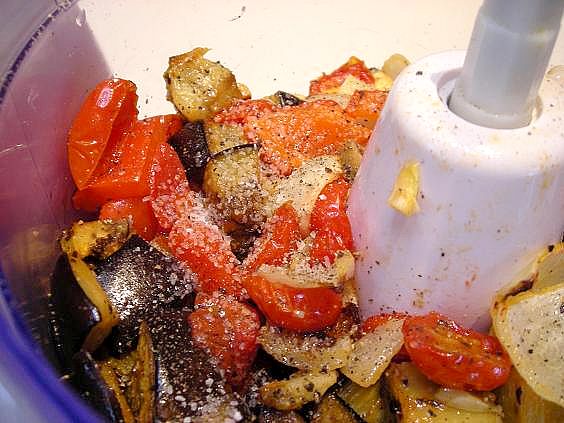
Add in about a cup of the pasta water and another healthy glug of olive oil. Whir the veggies to a consistency of choice- I like it a bit chunky- and scrape down the sides. Now take a look at the mix- it should be fairly thick. Add in a little more pasta water to make it to a spreading consistency. If it’s too thick, it won’t coat the pasta well enough.
You can also add in some kalamata olives, and be sure to have some fresh grated parmesan ready.
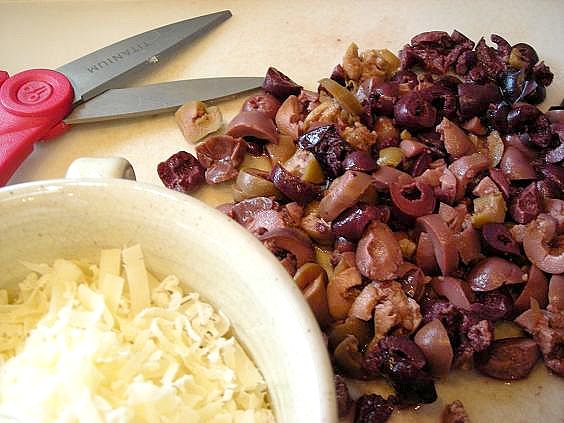
And if you’re like me and enjoy something crunchy, toasted and seasoned on top of your pasta, make some bread crumbs. I took a shortcut this time and put the remains of these bagel chips through the food processor.

Oh my, this was a really good addition!
Once the veggies are processed, scoop some of the puree onto your rigatoni or other large shape of pasta. This is such a hearty dish that a tiny shape would get lost in amongst the lovely vegetable mix. You may not need all the puree so add as you go to make it the consistency you like. Stir, taste, season with salt and pepper and taste some more.
Then, take your serving, add in the parmesan and crumbs and pick up a fork.
 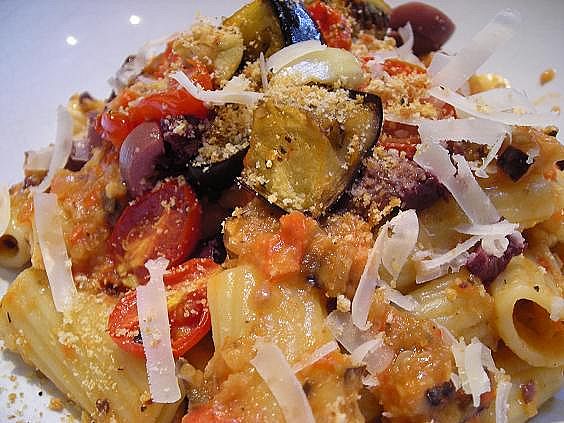
Mmmmm….. who needs convention anyway??
The puree was really thick and delicious- not so visible in these photos but trust me…each bite was a huge flavor burst in the mouth. There was plenty left over even after I coated the pasta with quite a bit. The next day I could hardly wait to take the remains of the vegetable mixture, spread it on toasted peasant bread and top it with fresh mozzarella. This made for a quick and delicious light lunch. I also think it would make a wonderful appetizer for a party.
Ok, if you need a set of instructions, follow the jump…..
Come in to my kitchen…
|

























 (Not exactly the Beauty Queen of Cuisine…..but oh so delicious!)
(Not exactly the Beauty Queen of Cuisine…..but oh so delicious!)








